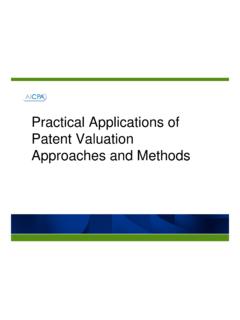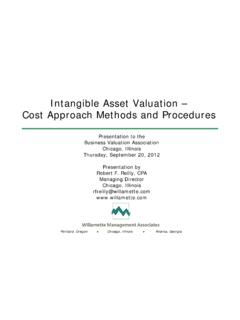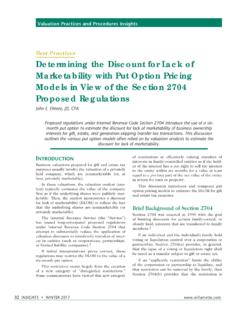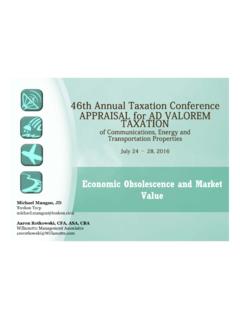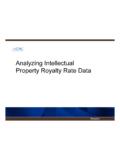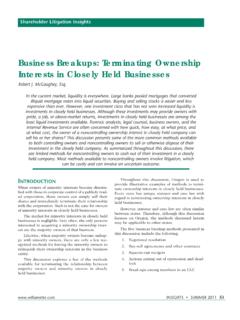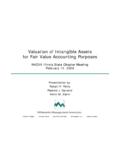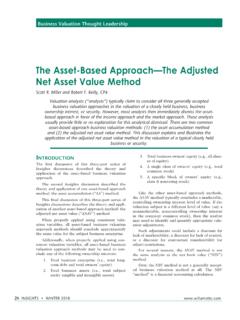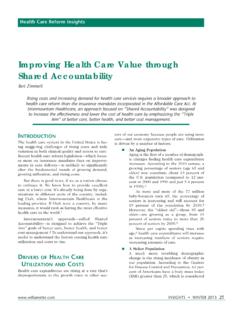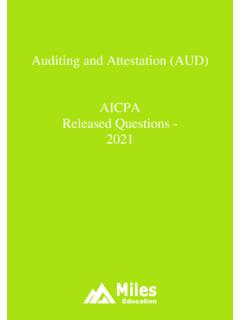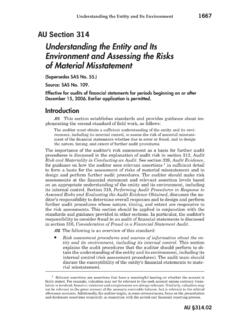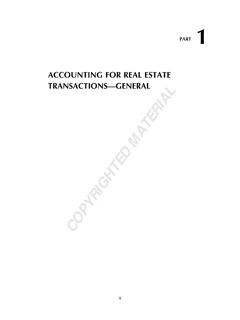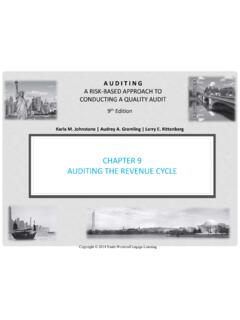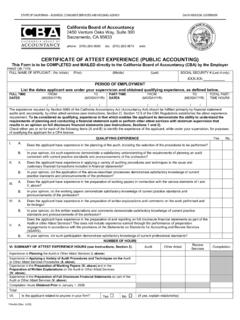Transcription of Fundamentals of the Asset-Based Business Valuation Approach
1 Business Valuation Thought Leadership Thought Leadership Discussion Fundamentals of the Asset-Based Business Valuation Approach Weston C. Kirk and Kyle J. Wishing Valuation analysts ( analysts ) value closely held Business and Business ownership interests for various transaction, financing, taxation, accounting, litigation, and planning purposes. Analysts should consider the application of all three generally accepted Business Valuation approaches in these analyses: the income Approach , the market Approach , and the Asset-Based Approach . However, most analysts rarely apply the Asset-Based Approach , at least in valuations of going-concern operating companies. This discussion describes the theory and application of the Asset-Based Approach . And, this discussion explains how this Approach can be used to value operating companies as well as asset-holding investment companies on a going-concern basis.
2 The Asset-Based Approach is not usually recommended as the sole basis for the Business Valuation . However, due to data or other constraints, the income Approach and the market Approach are not always available to value an operating company. In addition, the Asset-Based Approach may be used as a complementary or confirmatory analysis in conjunction with both income Approach and market Approach Valuation analyses. Introduction ning, a Business ownership transition, or a Business merger and acquisition structuring. In addition, the Valuation analysts ( analysts ) are often asked by current and ongoing value of the Business may be clients, by their clients' legal counsel ( counsel ), or important when the client (or counsel) is designing by their clients' other professional advisers to value or implementing buy/sell agreements or other share- closely held businesses and professional practices, holder agreements.
3 Business ownership interests, and securities for The Business or security value can be important various reasons. The value of the closely held busi- for various taxation planning, compliance, and con- ness or professional practice may be important for a troversy reasons. These taxation-related reasons variety of client purposes. include gift tax, estate tax, generation-skipping These client purposes may include transaction transfer tax, and income tax. pricing and structuring, taxation planning and com- Some of the income tax issues may include pliance, financing collateralization or securitization, worthless stock deductions, charitable contribu- forensic and economic damages analyses, corporate tions, stock or asset basis determination, insol- strategy and personal financial planning, financial vency related to debt cancellation income, inter- accounting and public reporting, and regulatory company transfer price determination, reasonable- compliance or controversies.
4 Ness of shareholder/employee compensation, and The value of the Business , Business ownership others. interest, or security could be important to the client The value of the Business or security may be (or counsel) with regard to Business estate plan- important when the client is involved in a family INSIGHTS WINTER 2018 3. law dispute, commercial bankruptcy matter, share- Approach in the typical closely held Business or holder dispute, lender liability claim, infringement security Valuation . This is because these analysts claim, many types of breach of contract claims, and (and clients and counsel) are not sufficiently famil- many types of breach of fiduciary duty or other tort iar with the generally accepted methods and proce- claims. dures within this Business Valuation Approach .
5 Such litigation-related matters may include dis- In addition, many analysts (and clients and senting shareholder appraisal rights claims and counsel) labor under misconceptions about when . shareholder oppression claims. and when not to apply this Valuation Approach . And, many analysts (and clients and counsel). also hold misconceptions about interpreting the Generally Accepted Business quantitative results of the Asset-Based Valuation Approach . Valuation Approaches Hopefully, this discussion will correct many of Regardless of the purpose of the closely held busi- the common misconceptions about this Business ness or security Valuation , analysts should con- Valuation Approach . This discussion will present the sider all three generally accepted Business Valuation most important considerations that analysts, cli- approaches.
6 These approaches (or categories of ents, and clients' professional advisers need to know related Business Valuation methods) are as follows: with regard to the Asset-Based Approach Valuation of 1. The income Approach closely held companies, professional practices, and Business securities. 2. The market Approach 3. The Asset-Based Approach As will be discussed below, the proper applica- tion of this Business Valuation Approach requires a slightly different set of skills than does the Although less commonly applied than the income application of the income Approach or the market Approach or the market Approach , the Asset-Based Approach . Not all analysts have the experience or Approach is a generally accepted Business Valuation expertise to perform a comprehensive Asset-Based Approach .
7 The Asset-Based Approach is described Approach Business Valuation analysis. in most comprehensive Business Valuation text- It is also true that the completion of the asset- books. In addition, consideration of the Asset-Based based Approach often requires more analyst time Approach is required by most authoritative Business and associated cost than other Business Valuation Valuation professional standards . approaches. That additional analyst time typically For example, professional standards such as the translates into additional professional fees charged american institute of certified public accountants to the client. Therefore, clients often discourage the ( aicpa ) Statement on standards for Valuation use of the Asset-Based Approach when they come to Services ( SSVS ) and the Uniform standards of learn of both (1) the additional elapsed time and (2).
8 professional Appraisal Practice ( USPAP ) require the additional costs associated with this particular the Valuation analyst to at least consider the appli- Valuation analysis. cation of the Asset-Based Approach (in addition to Also, the successful performance of this valua- other Business Valuation approaches). tion Approach often requires more data from and That is to say, such professional Business valu- more involvement by the subject closely held ation standards require the consideration of but company executives. Again, when these additional not necessarily the application of the Asset-Based commitments are understood, many clients may Approach . discourage the use of the Asset-Based Approach . In practice, however, many analysts (and many In many dispute-related Business Valuation clients and legal counsel) immediately reject the assignments, the analyst may not be granted suf- use of Asset-Based Approach methods in a busi- ficient access to the closely held company facilities ness, professional practice, or security Valuation .
9 Or to the closely held company executives in order These analysts conclude that this Approach is too to practically implement this Valuation Approach . difficult, too time consuming, too client disrup- In addition, particularly in a retrospective tive, or simply (and only without adequate expla- assignment, the subject company data that the nation) not applicable to the subject closely held analyst needs and the subject company personnel company. that the analyst needs access to are simply no In truth, many analysts (and clients and counsel) longer available. In many of these controversy- do not seriously consider applying the Asset-Based related contexts, it may simply be impractical for 4 INSIGHTS WINTER 2018 the analyst to perform some Asset-Based Approach of these Business value conclusions will be perfect- Valuation methods.
10 Ly appropriate in the right circumstance usually This first discussion in this three-part series based on the actual or hypothetical transaction that of Insights discussions relates to the application is being analyzed. of the Asset-Based Business Valuation Approach For example, knowing the company's total asset within a transaction, taxation, or controversy con- value is necessary in an acquisition structured as text. This Insights discussion describes the theory an asset purchase (instead of as a stock purchase). of and the general application of the Asset-Based The company's total invested value ( TIC ) often Approach . called the market value of invested capital (or The second discussion in this three-part series MVIC ) is the value of all long-term debt plus all of Insights discussions describes and illustrates a classes of owners' equity.
